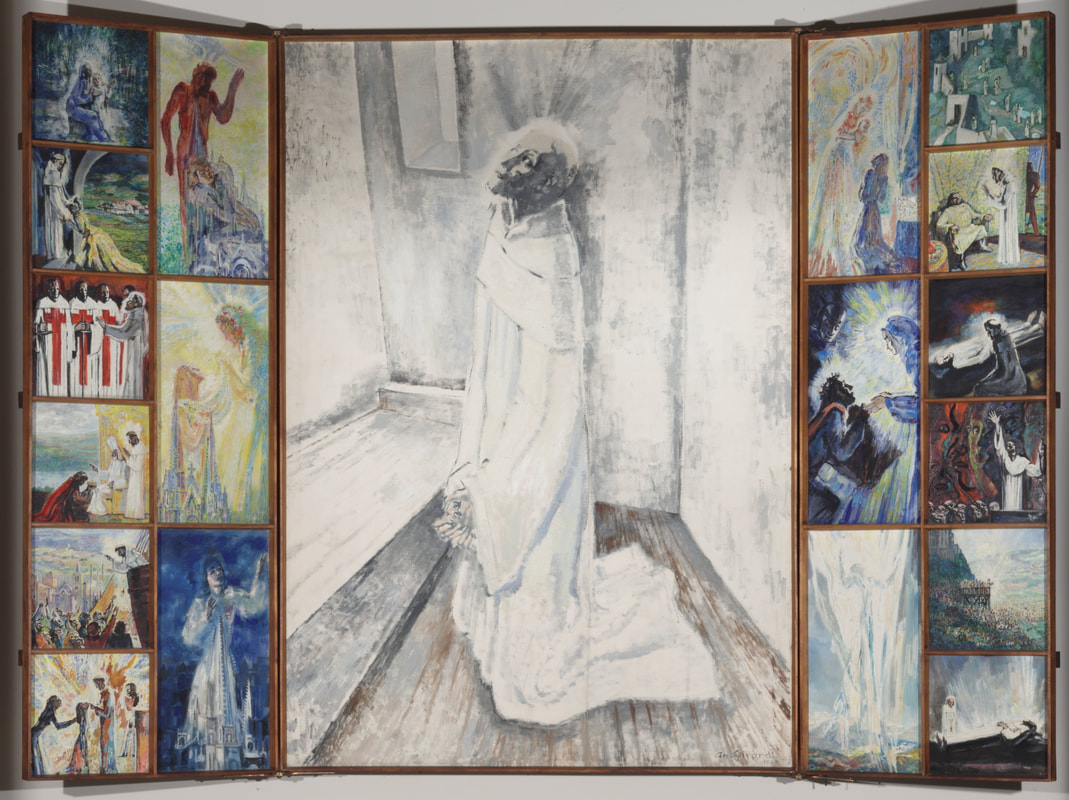André Girard, French, active in the United States, 1901–1968, The Life of Saint Bernard of Clairvaux, 1948, oil on canvas, 69 1/2 x 97 1/2 in. (open), 69 1/4 x 48 1/2 in. (closed), Saint Vincent Archabbey Collection. Photo: Richard Stoner.
At the age of seventeen, André Girard met famed French Fauvist Georges Rouault at the École des Beaux-Arts in Paris and studied under him until Rouault’s death. Much like his mentor, Girard was a deeply devout artist. Both shared a desire to articulate the liberating power of religious subjects animated for modern audiences. In 1948 Girard was commissioned by Saint Vincent to execute a work depicting St. Bernard of Clairvaux (1090–1153) intended for the Archabbey’s crypt. Among the most significant ecclesiastical leaders of the medieval period, Saint Bernard pioneered a reform of the Benedictines that culminated in the founding of the Cistercian Order. Girard focuses our attention on Bernard’s sermons, the Canticle of Canticles. Inspired by his mystical experiences, Saint Bernard’s writings are rich with imagery often exploring Mary the Mother of Christ and the intimate Biblical courtship allegory found in the Song of Songs. Prior to completing his final version, Girard painted four versions of the triptych in addition to dozens of studies illustrating these texts.
The triptych doubly honors the patronage of the Abbey of St. Bernard, founded in 1891 by monks of Saint Vincent who had been ministering to German immigrants that settled in northern Alabama. A variety of scenes from the life of the 12th century spiritual master are composed into film-like cells, giving Girard’s triptych a strong cinematic quality. Rather than employing a conventional halo to indicate a sacred presence, light emanates from Girard’s figures creating a strong aural effect.
The triptych doubly honors the patronage of the Abbey of St. Bernard, founded in 1891 by monks of Saint Vincent who had been ministering to German immigrants that settled in northern Alabama. A variety of scenes from the life of the 12th century spiritual master are composed into film-like cells, giving Girard’s triptych a strong cinematic quality. Rather than employing a conventional halo to indicate a sacred presence, light emanates from Girard’s figures creating a strong aural effect.
In the years following his commission at Saint Vincent, Girard developed the technique of painting directly on film. Unsatisfied with the way television cameras represented his work, Girard would painstakingly render his images first on 70mm film in black and white and then in color before capturing them on 35mm film in an unedited sequence. These films focused exclusively on religious themes that included the Sermon on the Mount recounted in Matthew’s Gospel, the Passion and Resurrection of Christ, and the life of the Patriarch Abraham. In 1959, Girard’s films were initially presented through national broadcasts and later at congregational viewings. Referring to his process as “painting on light,” it was Girard’s intent to innovatively employ new technologies in the service of the Gospel.
André Girard, French, active in the United States, 1901–1968, Saint Bernard in the Woods, 1948, oil on panel, Saint Vincent Archabbey Collection.


